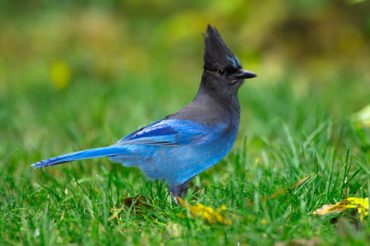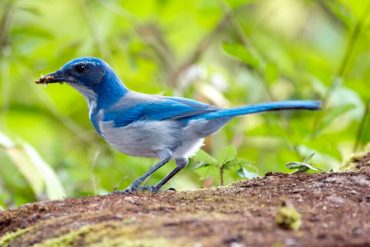
Every West Sound birder has heard it. Someone claiming to have seen a blue jay. Yes, the individual saw a “blue jay,” but it was likely not a bona fide blue jay, a common species in the central and eastern United States and southern Canada, but a rarity in Washington.
Occasionally, an actual blue jay finds its way to West Sound, where it may spend the winter eating peanuts and sunflower seeds from feeders while delighting local birders who flock to see it.
Here in West Sound, the resident “blue jays” are close relatives of true blue jays. They are the traditionally common Steller’s jay and the increasingly common California scrub-jay (formerly known as “western” scrub-jay).
Steller’s jays and California scrub-jays are members of the corvid family, which also includes ravens and crows. Though they are considered songbirds, their loud, raspy calls are in no way melodic.
Although it makes a stellar appearance, the Steller’s jay is actually named for Georg Steller, a naturalist who discovered the species on an Alaska island in 1741. Slightly bigger than a robin, it’s the only jay with a black head and crest atop its black chest and shoulders. The striking, deep-blue wings, flanks, belly and tail make identification easy.
The Steller’s jay is a year-round resident of montane and coastal coniferous forests of western North America. It also visits parks and backyards, and is common throughout West Sound.
Steller’s jays do most of their foraging in trees. They have an omnivorous diet that includes insects, berries, nuts, seeds and even small mammals, reptiles and carrion. Steller’s jays can also be major predators of eggs and nestlings of other birds. They readily visit backyard feeders, particularly enjoying peanuts, suet and sunflower seeds.

Outside of the nesting season, Steller’s jays form small, noisy flocks. They typically fly from place to place in single-file formation, making them easy to count during bird surveys. In breeding season, Steller’s jays settle down in pairs and quietly go about the task of raising a family.
They are monogamous and typically nest high in a tree next to the trunk. The nest is made of twigs, leaves and moss, which is glued together with mud. Each year, they raise a single brood of four or five chicks, which are ready to leave the nest after 16 days. Both parents care for the fledglings and will assist them for about a month.
Steller’s jays are fearless when facing a predator and will often mob an intruder. Even a lone individual will take it upon itself to chase off a barred owl that is surveying a backyard feeding station.
For the last 40 years, the California scrub-jay has been expanding its range northward from the American Southwest. This new “blue jay” is now a fairly common year-round resident of West Sound, particularly around Bremerton and Hansville.
Oak woodlands are the preferred habitat of California scrub-jays. They can also be found in agricultural areas and lowland suburban neighborhoods and parks, especially those with hardwood trees. California scrub-jays rarely venture into the mountains or coniferous forests.
Unlike its darker cousin, the California scrub-jay doesn’t have a crest. Its head, tail and upper parts are predominantly sky-blue with a gray back. The belly is light gray and a blue “necklace” contrasts nicely against its white throat.
Differing from the high-nesting habits of Steller’s jays, California scrub-jays prefer to nest in low trees or shrubs. The pair constructs a thick nest cup of grass, twigs and moss. Like its cousin, the female has the duty of incubating the clutch of three to six eggs, while the male brings her food. Both parents care for the chicks, which are ready to fledge after 18 days.
A California scrub-jay does most of its foraging on the ground. Its diet is similar to the Steller’s jay and includes acorns. A resourceful species, the California scrub-jay uses hard surfaces, such as rocks and concrete, as anvils for opening acorns.
The California scrub-jay digs holes in the ground to store acorns for winter meals. Like its cousin the blue jay, it unknowingly plants new oak trees by not retrieving all of the cached acorns, supplying future generations of jays with a steady food source.
Steller’s jays and California scrub-jays are unique in that both have benefited from urban development. Unlike many other species of birds whose numbers are diminishing from habitat loss, these corvids are getting along fine with their human neighbors. As a result, they are increasing their numbers and expanding their range.
Steller’s jays and California scrub-jays are species that out-of-state birders hope to see when visiting Washington. They are interesting to watch and add a splash of color to our neighborhoods. The “blue jays” of West Sound should not be ignored.



























